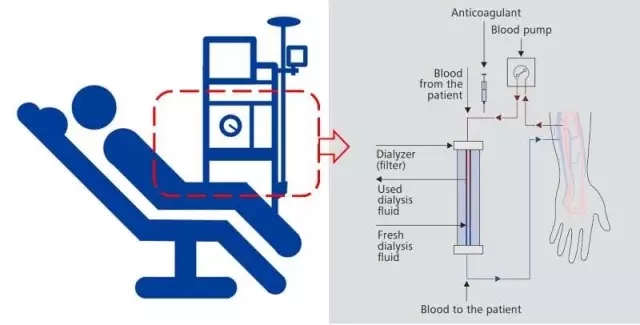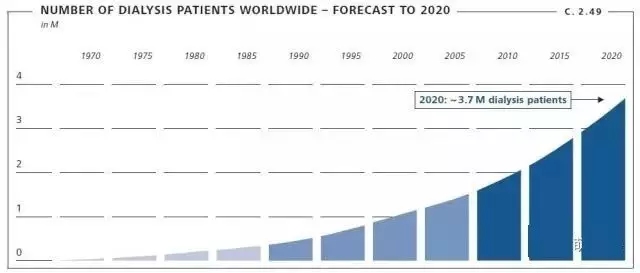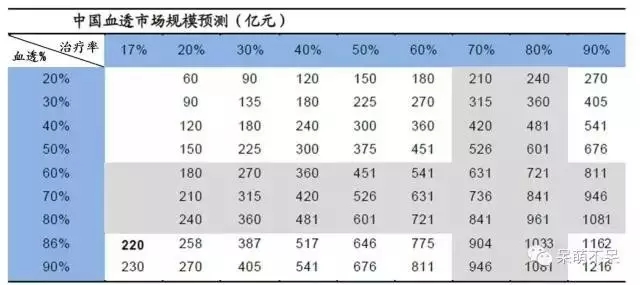Hemodialysis (HD) is one of the renal replacement treatments for patients with renal failure. By draining blood from the body to the outside of the body, it passes through a dialyzer consisting of a myriad of hollow fibers. The blood and the electrolyte solution (dialysate) containing a similar concentration of the body are inside and outside the hollow fiber, passing through the dispersion/convection/ultrafiltration. Material exchange, removal of metabolic waste in the body, maintenance of electrolytes and acid-base balance; while removing excess water from the body, and the process of returning purified blood to the patient is called hemodialysis. See the following diagram and a partial enlargement example for easy understanding.

Global hemodialysis profile
In recent years, the number of dialysis patients worldwide has increased by 6% per year. According to conservative estimates, the number of patients receiving dialysis treatment by 2020 is about 3.7 million, and the number of patients receiving dialysis treatment by 2030 will be 6.5 million. However, the global dialysis market is not well developed. The United States, the European Union, China, Japan and Brazil account for more than 50% of the world's patients. The United States, the European Union and Japan in the three major regions of the original ICH are relatively mature dialysis markets, with the characteristics of perfect medical system, excellent dialysis hardware and technical conditions, and high patient treatment rate. According to 2013 statistics, Japan has the highest dialysis treatment rate of 2,505 per million people; followed by the United States, reaching 1,420 per million people. In developing countries, due to economic and medical conditions, the treatment rate of patients with end-stage renal disease needs to be improved. For example, the dialysis treatment rate in Brazil is 575 per million people, and the dialysis treatment rate in China is only 245/1000000.
Changes in global dialysis patients from 1970 to 2020 and projections (in millions)

Source: Fresenius Medical Care Annual Report of 2016
The world's population is growing, especially in Asia, Latin America and Africa. The relative growth is relatively fast, with a compound growth rate of nearly 1.5%. In addition, the global aging problem has further promoted the diaper industry's 6% annual growth.
In my opinion, in recent years, Europe and the United States are still the main battlefields of the hemodialysis industry. This is mainly due to the combination of earlier medical accessibility, aging and better national medical insurance and commercial insurance. result. In developing countries such as China and India, due to the large population base and rapid population growth, with the continuous efforts of the government, the medical infrastructure has been continuously improved, and the number of medical talents has also increased year by year. The overall economy has developed steadily and the local urban economy has developed rapidly. Patients who have had kidney disease but have not been treated are increasingly getting access to treatment. Therefore, the hemodialysis market is now in Europe and the United States, but in the end it belongs to emerging markets such as China. How can this be seen, with two dimensions of data: the rate of dialysis treatment and the percentage of people who choose to pass through to predict the size of the Chinese hemodialysis market.
At present, the per capita annual blood perfusion is about 75,000 yuan;
The total number of patients with ESRD (End Stage Renal Disease) is about 2 million, and the number of patients is not considered.
Hemodialysis market size = total number of ESRD patients × dialysis treatment rate × proportion of hemodialysis × single hemodialysis cost
The predicted data is shown in the table below:

Source: China Green Paper on Health Development
HD's current domestic market size is about 50 billion yuan. As can be seen from the above table, without considering the increase in the number of patients with end-stage renal disease, as long as the dialysis treatment rate and the percentage of selected hemodialysis are increased by about 80%, the market size will double to reach 100 billion yuan. . The actual situation is that the number of patients with end-stage renal disease in China is increasing year by year, so the above model is an example, and there is still much room for improvement in the hemodialysis market.
Natural Corn Silk Extract Powder,Candy Plant Extract,Pure Natural Gardenia Extract
Fufeng Sinuote Biotechnology Co.,Ltd. , https://www.sntextract.com